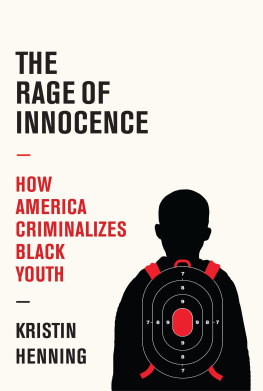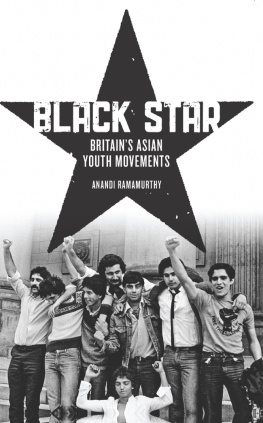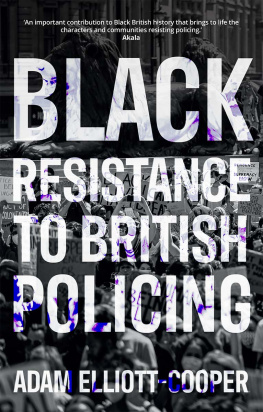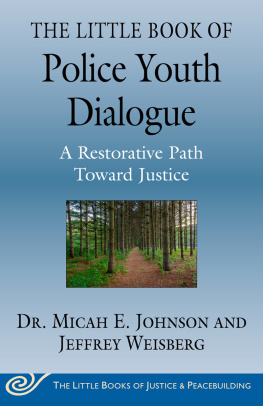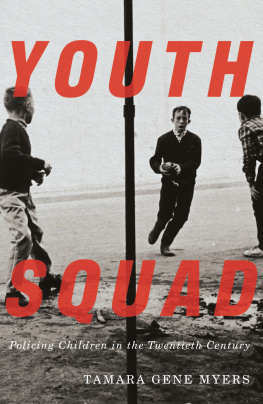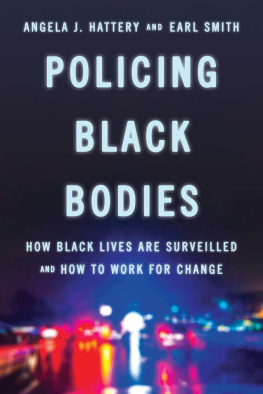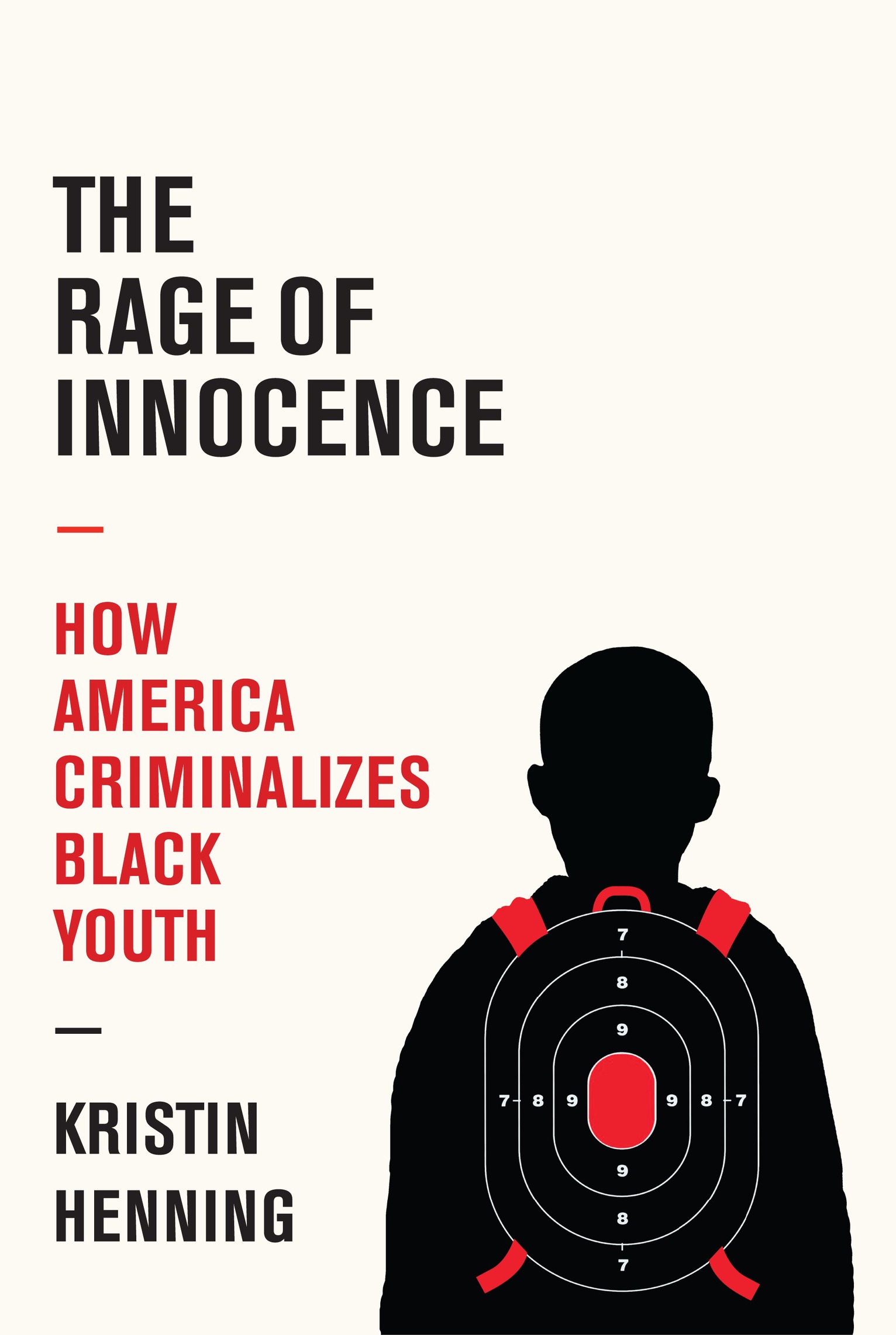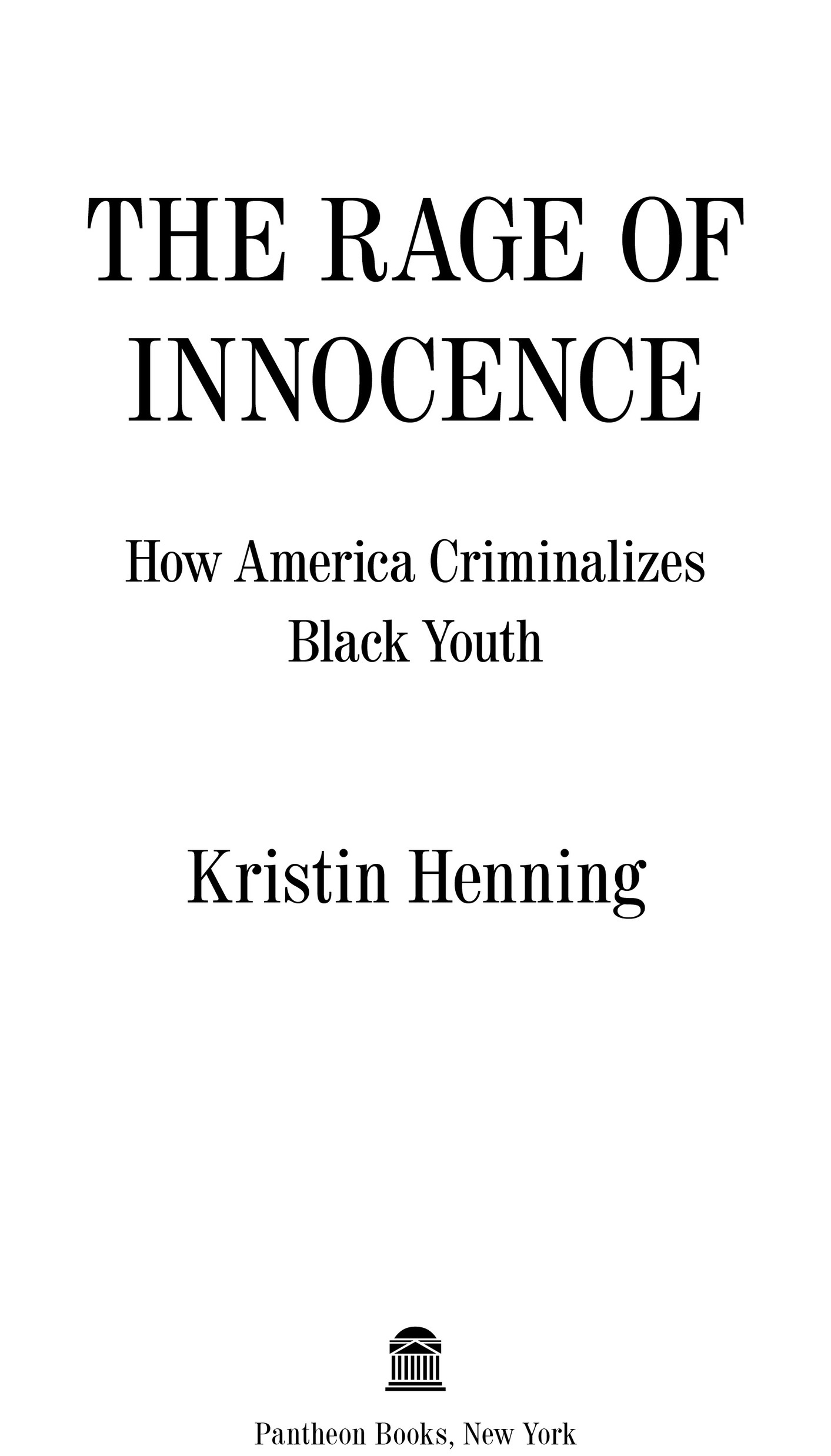Contents
Landmarks
Print Page List
Copyright 2021 by Kristin Henning
All rights reserved. Published in the United States by Pantheon Books, a division of Penguin Random House LLC, New York, and distributed in Canada by Penguin Random House Canada Limited, Toronto.
Pantheon Books and colophon are registered trademarks of Penguin Random House LLC.
Library of Congress Cataloging-in-Publication Data
Name: Henning, Kristin (law teacher), author.
Title: The rage of innocence : how America criminalizes Black youth / Kristin Henning.
Description: First edition. New York : Pantheon Books, 2021. Includes bibliographical references and index.
Identifiers: LCCN 2021002180 (print). LCCN 2021002181 (ebook). ISBN 9781524748906 (hardcover). ISBN 9781524748913 (ebook).
Subjects: LCSH: Discrimination in juvenile justice administrationUnited States. Discrimination in criminal justice administrationUnited States. African American youth. Policecommunity relationsUnited States. Racial profiling in law enforcementUnited States. Discrimination in law enforcementUnited States. RacismUnited States.
Classification: LCC HV9104 .H46 2021 (print) | LCC HV9104 (ebook) | DDC 364.36089/96073dc23
LC record available at lccn.loc.gov/2021002180
LC ebook record available at https lccn.loc.gov/2021002181
Ebook ISBN9781524748913
www.pantheonbooks.com
Cover design and illustration by Oliver Munday
ep_prh_5.8.0_c0_r0
Contents
Introduction
Molotov Cocktail or Science Experiment?
I first heard about Eric on the evening news when I saw the headline Teen Arrested for Bringing Explosive Device to D.C. School. The story immediately caught my attention. It sounded serious, and as a defense attorney practicing in Washington, D.C.s juvenile court, I knew I would likely see Eric in court the next day. Indeed, as fate would have it, just as I walked into the courthouse, a teenage girl approached me to ask if I could represent her brotherEric. Coincidentally, I had met Erics sister a few months earlier in a drama workshop at a local high school. As I checked in with the court staff, I learned that I had already been appointed to Erics case.
Within minutes of talking to Eric in the juvenile lockup, I realized that what sounded so shocking on the news wasnt so serious after all. Eric was a typical thirteen-year-old boy who was watching a movie and saw someone with a Molotov cocktail. Eric thought it was cool and wanted to see if he could make something that looked like that. He grabbed an empty bottle from under the kitchen sink and started filling it with household productsbleach, Pine-Sol, stainless steel cleanerwhatever he could find. He didnt research it. He didnt look up Molotov cocktail on the internet, and he didnt know if any of the products he grabbed were flammable. He was just being creative. He taped up the entire bottle with black tape and put a long piece of toilet paper underneath the cap so it hung out of the bottle like the wick of a cocktail. After admiring his design, Eric put the bottle in his book bag so it wouldnt spill on his mothers white carpet and moved on to his next source of entertainment for the day. This all happened on a Saturday night, and like most thirteen-year-olds, he had completely forgotten about it by Monday morning when his mother drove him to school.
As he did every school day, Eric walked through a metal detector and put his bag on an electronic conveyor belt. A police officer assigned to the school as a school resource officer saw the bottle and stopped Eric to ask about it. Eric responded without thinking, Oh, thats nothing. You can throw it away. He walked on to class. Little did he know this was the beginning of a very long and painful ordeal for him and his family in juvenile court.
Eric was pulled out of class, questioned by the police, and arrested. No one believed him when he told them he forgot the bottle was there and was not planning to blow up the school. Eric spent the night in the local juvenile detention center and was brought to D.C. Superior Court the next day. The prosecutor charged him with possession of a Molotov cocktail, attempted arson, and carrying a dangerous weapon. When I heard the prosecutor read out the charges, I kept expecting there to be more to the storymaybe a letter or some cryptic online message by Eric threatening to hurt a teacher. Maybe Eric was sad, isolated, and bullied by his classmates. Maybe Eric had a history of depression and dressed in all black. None of that turned out to be true. There was nothing more to the story.
Quite to the contrary, Eric was a happy and creative Black boy living in Southeast D.C. with his mother and little brother. Although his father was in prison at the time, Eric was raised in a large close-knit family, including two older sisters in college and another in the U.S. Air Force. His mother worked in a hospital and catered food a bit on the side while studying for her nursing degree. His father was a college graduate who had worked for many years as an emergency medical technician before his incarceration. I visited Erics home many times and met many of his family members over the next several months. I saw nothing other than a well-adjusted boy who loved to show me his kittens and play with his brother. He was active in youth theater, participated in the citys local youth orchestra, and tutored second- and third-grade students in reading four days a week. He also enjoyed youth activities at church. His teachers described him as calm and respectful, and he had never been in trouble at school or with the police.
The only thing that could really explain the schools extreme reaction to Erics duct-taped bottle was our countrys outsized fear of school shootings. And for a while, I accepted that as the reason. I let myself believe that our schools were just being extra careful in the era of mass violence. But then something happened that forever changed my view of this case. Several months after I met Eric, I shared his story at a conference in New Haven, Connecticut. When I finished, a White woman walked over and said, My son did exactly what you described. He tried to make a Molotov cocktail and took it to school. When I asked what happened to her son, she said, They rearranged his class schedule so he could take a chemistry course.
No, we are not just afraid of school shootings. And we are not just afraid of children with guns. We are afraid of Black children. There was nothing Eric could have done or said that day to convince the police or anyone else that he was not a threat to the school.
Eric was suspended and banned from all after-school activities. For the next nine months, he met weekly with a probation officer, was forced to attend anger management classes, and had to pee in a cup to prove he was not using drugs. At the citys expense, lawyers on both sides of the case spent hours investigating, preparing, and arguing about every legal question we could think of. Our defense team even hired an arson expert to prove that the liquids in the bottle would never catch on fire and the toilet paper hanging out of it would never work as a wick. Only after months of advocacy were we able to persuade the judge to dismiss Erics case under a special law in D.C. that allows a judge to throw out a juvenile case when it is in the interest of justice. Fortunately, our judge thought the school and the police had overreacted. Unfortunately, the dismissal could never undo the agony, embarrassment, and fear Eric and his family experienced that year.

